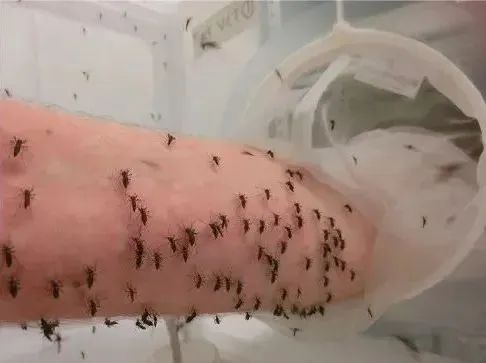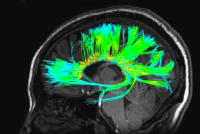Keeping mosquitoes is the first step.
Collecting mosquito eggs in the wild and bringing them back to the laboratory for hatching is easy to say, but how to raise them? Or, how to feed them blood?
Aedes aegypti does not like animal blood, so the method commonly used in the laboratory of “wrapping rabbit blood with a thin plastic film to simulate the skin” is not very effective; the simplest and most efficient way is to put the arm directly into the mosquito cage.
Is it so dangerous? Zhao Zhilei explained that this method of feeding mosquitoes is based on the understanding of mosquito biology and has been approved by the ethics committee; of course, it is also completely voluntary.
And, don’t worry, this method won’t spread the disease.
He explained that mosquitoes are only the medium of pathogen transmission, not the source of its production, and it will not spread across generations, so mosquitoes hatched from eggs in the laboratory are very “clean” and do not carry pathogens. At the same time, the laboratory has clearly stipulated that the same batch of mosquitoes can only be “raised” by the same person, so it will not cause human-to-human transmission.
In Lindy McBride’s laboratory, a “ruthless” colleague set a record of feeding 3,000 mosquitoes in one day.
Zhao Zhilei, who is slightly thin, has a record of 1,500. The first time he fed mosquitoes, his arm was swollen and itchy for a long time. Later, Lindy McBride asked him to rinse with hot water (which can accelerate the blood circulation of the skin), and then the swelling slowly disappeared.
A few months later, Zhao Zhilei no longer felt the itch when he fed the mosquitoes by hand, because “the immune system has adapted”, he said.
Through comparison, the research team found that compared with animals, human odor is not unique to any chemical molecule, but there are several molecules in particular, such as decanal and methylheptenone.
These two molecules are the products of oxidation and decomposition of certain oily substances secreted by human sebaceous glands after contacting the air. These oily substances, the sebum of animals is almost not secreted, which also explains why the “human taste” is so special.
The next step is to find out why mosquitoes like “human taste” so much?
If they could know which part of the brain is activated in mosquitoes when they smell “human”, they can further investigate whether the mosquito brain is sensitive to certain molecules (such as decanal or methylheptenone) Have a soft spot?
If you solve this problem, you will not only be able to decipher the criteria for mosquito selection in one fell swoop, but it will also be very useful-compared to the “human taste” composed of hundreds of molecules, specific chemical molecules are easier to manufacture and store, which will be more convenient Make a new mosquito trap.
The answer does lie within this hypothesis: Their subsequent research found that mosquitoes prefer people with moderate levels of decanal in their body odor.
Zhao Zhilei explained that a potential reason is that there are few people in the population with little or a lot of decanal. If mosquitoes tend to like such people, the probability of finding a suitable person will decrease, which is not conducive to their reproduction.
But in the study, the “craniotomy” of mosquitoes was not so easy to do – they had to keep the mosquitoes alive after the craniotomy.

Gene editing technology makes this bold experiment feasible.
By editing mosquito genes, the nerve cells in the mosquito brain are specifically marked so that they express fluorescent proteins. In this way, when nerve cells in a certain brain region of the mosquito are activated, the fluorescence is enhanced, so that it can be known which brain region is activated.
However, the success rate of gene editing mosquitoes is too low, less than 0.1%.
“I was in a bad mood at that time. But I calmed down and analyzed it carefully. In fact, the negative results also laid the foundation for our subsequent success.” Zhao Zhilei said that a good experimental design, regardless of whether the results meet the initial expectations, provides very useful Information, which can be used to continually revise and refine our understanding of nature, “is also an important part of evaluating our contribution to the field.”
In this way, it took five years repeatedly for the research team to produce transgenic mosquitoes for experiments one after another.
They found through experiments that although there are nearly 100 chemical molecules in human odor, only two areas are activated in the primary olfactory brain area of mosquitoes.
They paired a mixture of just two chemical molecules to activate the two brain regions and found that it had a strong attraction to mosquitoes, just like the scent of a real person.
“We have applied for a patent, hoping to apply this mixture to mosquito traps to attract and kill mosquitoes.” Zhao Zhilei revealed that there are already several companies developing mosquito control products that are negotiating with them on patent transfer and cooperation.
In addition, Zhao Zhilei said that his colleagues are also exploring another idea: if a compound can be screened that can specifically inhibit the two brain regions activated by “human taste”, then this compound may be used as a Use mosquito repellent – it interferes with mosquitoes’ sniffing of people.




GIPHY App Key not set. Please check settings